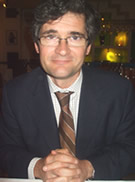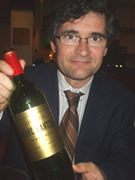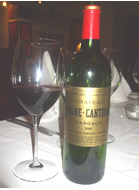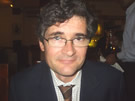Second Growths from the classified Bordeaux, or second wines of First Growths are generally good value for the tax-burgeoned Indian consumer, but the second wine from Margaux based Second Growth like Brane Cantenac can be super-value-for-money, as I discovered during an exclusive interview with Henri Lurton, the visiting owner of the Chateau.
 Baron de Brane is the second wine dedicated to the Baron of Barone who bought the estate in 1833 after selling Brane Mouton (now Mouton- Rothschild). It uses similar grape blend except that is aged for 12 months in the barrel instead of 18 months for the chateau wine, Brane Cantenac. Baron de Brane is the second wine dedicated to the Baron of Barone who bought the estate in 1833 after selling Brane Mouton (now Mouton- Rothschild). It uses similar grape blend except that is aged for 12 months in the barrel instead of 18 months for the chateau wine, Brane Cantenac.
Due to the style of making, the BB can be ready for drinking in 3-5 years while the first wine would need to sleep in the barrel and bottle for a minimum of 8 years. Of course, the chateau wine will age much longer, 50 years or more quite likely for good vintages. The 20 + years life expectancy of the Baron should be satisfactory enough for the Indian market, especially since it costs only 60% of B-C.
The Lurton Family
Pierre Lurton is a well-known name and face of Bordeaux; he is the head honcho of the world famous Chateau d’Yquem in Sauternes and Cheval Blanc in St. Emilion. But Bordeaux is full of Lurtons who seem to share the same blood line.
Henri (pronounced awn-ree) Lurton is Pierre’s cousin and has been the owner of the Margaux based Second Growth Chateau Brane (pronounces brawn) Cantenac since 1992, when his father Lucien chose him as the heir for this property and gave him the charge. Lucien has two brothers , Andre and Dominique ( who is Pierre’s father. )
Off-spring of the three brothers born to Francois Lurton, who bought the estate in 1922 with his father-in-law Léonce Récapet, have spread their wings in several wine estates in Bordeaux. Henri has nine siblings, two of whom were initially given a share of Brane by his father. Eventually, he bought out their share and is now the sole owner.
Henri Lurton was in Delhi on his way to Bangalore and Maldives at the invitation of Brindco. He was chatting with me exclusively about our common passion over dinner at Diva Restaurant , where we were enjoying a decanted bottled of the 2000 vintage of Brane-Cantenac. Here are the excerpts from the interview with the 47- year young enologist and viticulturist from the University of Bordeaux ( after studying Biology. )
Background of Brane
 ‘Although the history of Brane Cantenac is very interesting with the winery falling into the lap of my great grandfather in 1922, I believe that our wines are a product of the terroir. He owned 40% of Chateau Margaux but was obliged to sell it in 1947 since it was not easy to run a wine estate those days. ‘Although the history of Brane Cantenac is very interesting with the winery falling into the lap of my great grandfather in 1922, I believe that our wines are a product of the terroir. He owned 40% of Chateau Margaux but was obliged to sell it in 1947 since it was not easy to run a wine estate those days.
Over the years, the company has been buying plots of land from classified neighbours like Kirwan, Issan and Cantenac-Brown. Brane has now 75 hAs with one single piece of 45 hAs of prime property in Cantenac, a commune in Margaux.
Brane Chateau wine has been commanding the respect as the ‘first of second growths for several years. In 1899, it even fetched the same price as Chateau Latour. In the seventies and eighties, Brane was at the top of Second growths when it competed with labels like Cos d’Estournel and Cazes etc.
Brane and Robert Parker
‘Then came the era of Robert Parker who was not a fan of our wines because he preferred powerful wines compared to the elegant wines that we produce. Besides, my father has been a grower and not a marketer. When the other second growths like Pichon Lalande and Cos were building up their brands he was busy upgrading the wine quality and buying several new chateaux and vineyard parcels.’
‘Our wines have not been able to command as much price as they deserve. But I must emphasize that Parker has done a lot for Bordeaux since he is passionate about our region.’
Philosophy of Brane wines
‘Our philosophy is to make the best possible wine while remaining faithful to the terroir of our vineyards. We believe that excellence in the grape quality is essential for great wine. Our efforts are always to get perfectly ripe grapes. But I prefer more elegance to power in our wines so we don’t let them become over-ripe as Michel Rolland recommends’.
‘Quality of tannins is very important to balance with the aromatics of the grape. The age of vines is as important as the terroir. Therefore, we use older vines with average age of 30-35 years for our first wine. We also believe that blending is very important in making high quality wines. Sometimes, we wait till blending to decide whether the wine will go into the first wine or the second.
For full ripening, it is essential to do the phenolic and other tests before harvest but it is also important to actually taste the grapes to decide if they are fully ripe. My father taught me this process years ago before many people in Bordeaux made this a routine. Now, I can pretty much taste grapes from different parts of the vineyard and tell if it is fully ripe.
I must add that knowing your terroir is extremely important. What I can do for my property, I may not be able to do for other properties with as much ease or accuracy. We use sustainable processes in the vineyards and balance tradition with modern techniques where necessary and experiment constantly and innovating.’
‘We make wine which is the best the place can offer and then find people who like it. We do not look for what people like and then try to make the wine that they like because that may not be the best our terroir has to offer. People always have individual preferences. There are many who may prefer Petrus to Margaux and the other way around. It does not mean one is better than the other.’
Wines of Brane-Cantenac
 ‘I think a great wine must not only have a good structure and elegance but also should display good aromatic bouquets over time. In our wines, the bouquet develops gradually over a long period. It shows more depth and power over a period of time. ‘I think a great wine must not only have a good structure and elegance but also should display good aromatic bouquets over time. In our wines, the bouquet develops gradually over a long period. It shows more depth and power over a period of time.
Wine during an exceptional vintage can last much longer. We bought back a few bottles of 1928 which are still quite alive. The 1961 vintage, my year of birth, is still fine and kicking though I prefer 1959.’
‘For me, wine is not a fashion. It is a craftsmanship and for people who understand it. To me, it is not only balance and complexity but also the culture. These are the wines we like to produce and offer them at reasonable prices in order to increase our market share.
The Making of 2008 vintage
‘The 2008 was not showing well in spring. But it is showing well now. It is a wine for ageing.
We sell off 80-90% of our chateau wine and the Baron de Brane- sometimes even 95% is sold off. We also have a third wine, Chateau Notton , which we normally do not sell either in the En Primeur market; or in India.
Our philosophy is to make good quality wine and sell it at reasonable price, even if compared with the other second growths. Although prices of some of the second growths soared after Parker gave a good rating last month, neither our negociants nor we increased our prices.’
Brane Market
‘About 40% of our wine is sold in the French restaurants.’ The Indian Hoteliers will derive pleasure from the fact that his wines are marked up by 300-400 % by the up scale restaurants who sell his wine in Paris and other parts of France.
‘Switzerland and UK are our biggest markets and we are strong in Europe. These markets are looking for good quality wines but are not keen to spend outrageous prices charged by the First Growths.’
It is more difficult to sell wine where there is speculation. Our wines are for the drinking pleasure. Our philosophy is to keep the prices very low. The super seconds have very high price tags. We like to sell at a fraction of their prices- of course, always through negociants.’
Grapes of Brane
‘Like in the rest of Medoc, we use more of Cabernet, although our 2000 Chateau wine was an equal mix of Cabernet Sauvignon and Merlot. We do use about 5% of Cabernet Franc but hardly any Petit Verdot that forms the typical blend of Medoc. We are experimenting with Carmenére in a half hectare of plot, so we use about 0.5% in the blend. We find better results with Cabernet so we are heading for 70% of this grape in our future vintages.’
Wine and High Alcohol
Our wines generally have 13% alcohol and rarely does it go to 13.5%. But we cannot control the level. It depends upon the ripeness level in a particular vintage. Same goes for acidity-I don’t like to add acid. Although chaptalisation (adding sugar) is allowed, I am not a fan of this process either.
On multiple harvests in the vineyards
We harvest each parcel at one time only, when we feel the fruit is ripe enough. It is impossible to select grapes for harvesting on more than one occasion in Bordeaux. Sometimes you can check by the density of the grapes. There is now a machine that can tell from the colour of the grapes if it is time to harvest. White grapes can still be harvested, allowing for different ripening period- due to the colour changing to gold. But we harvest every parcel in one go, based on the average ripeness.
Wines you normally drink
I used to drink wines from outside Bordeaux, especially since I worked in Chile, South Africa and Australia before coming back to my roots. I used to get wines from Italy, Champagne, Alsace and Burgundy too. But here, it is easier to find Bordeaux wines. So I end up drinking more such wines.
Progressively strict anti-wine laws in France
Unfortunately, too many people have car accidents with drunk driving. But I know so many of our negociants who drink regularly but have never been involved in an accident. Moderate drinking is very important. Many years ago, a person would drink up to 12 liters a day. But then quality was not important. Things have changed now.
But with the strict laws, one can lose a license otherwise too- say by being 5 kph over the speed limit from Bordeaux to Paris. A person having 11 points against his license needs just one such citation to lose the license. So, I hope people realise this and do not mix driving and drinking. People are now drinking better wines. If they drink better wines, slowly with food, say a glass an hour, things could be under control.
Vision of the Indian market
I believe the market is opening for those people who love to have good food. I realise it will never be as big as the China market. But it is a question of wine culture developing too. Where there is a culture of cooking-especially complex cooking, it is easier to understand wine as it is a complex beverage.
I know it is not always feasible for our wines to work with Indian cuisine, but you can still enjoy these wines.
The interview ended with the last drop of 2000 Brane-Cantenac washed down with the saucy duck and potatoes- a beautiful marriage of wine with food.
Baron de Brane-Best Value
 Talking with Henri Lurton and discussing prices with him and the making of the wine, made me believe that his second wine black-on-silver labelled Baron de Brane may score over the Brane-Cantenac, their first wine. For those who can afford to store it for years, the latter may be a bonanza because it does not cost the earth as do the first growths and even a fraction of the super seconds. Talking with Henri Lurton and discussing prices with him and the making of the wine, made me believe that his second wine black-on-silver labelled Baron de Brane may score over the Brane-Cantenac, their first wine. For those who can afford to store it for years, the latter may be a bonanza because it does not cost the earth as do the first growths and even a fraction of the super seconds.
Of course, if you can buy it in Europe for about €22-23, the current vintages of 2007 and 2008 (the much hyped 2005 is available in Europe at €45 after touching € 60 before the recession hit) in the En Primeur market, it may be the best value over long term.
|